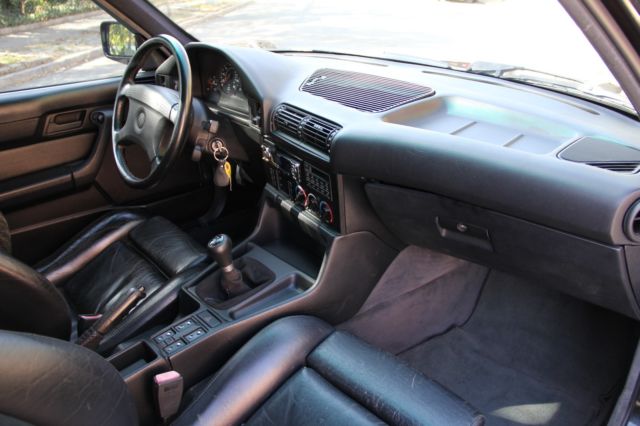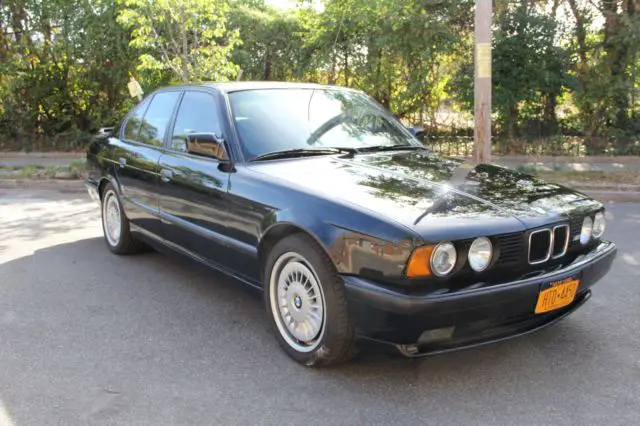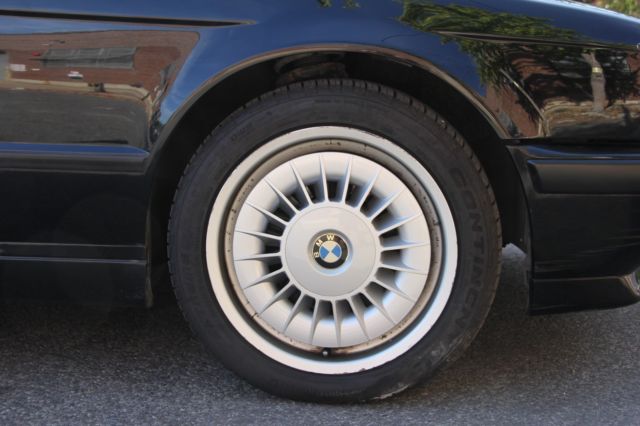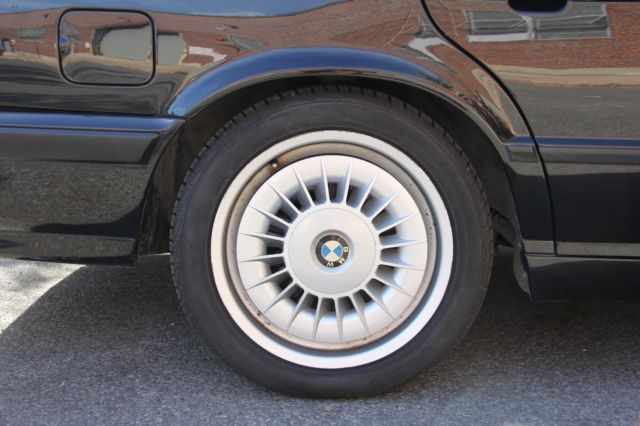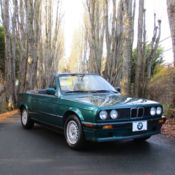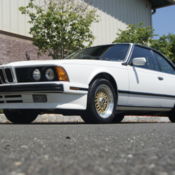West Coast Car * Rare * 1 of 1296 Made * Last of the Hand Built M Cars *
Price: -
Item location: Brooklyn, New York, United States
Description:
1991 BMW M5 Base Sedan 4-Door
Up for sale is my 1991 BMW M5. The car has a clean title and approximately 161,550 miles and is located in Brooklyn, NY. This is an opportunity to get a rare legend -- the last of the hand built BMW M cars (1296 made for the U.S. in 1991) at a very cheap price. Better yet, this is a west coast car (Washington State 1999-2017 and before that, Texas).Please read the entire advertisement before bidding.
Importantly, please note that the primary reason that the car is up for sale is due to a noise that is coming from the engine off-idle (over 1,500 RPM) and according to my mechanic, the rod and crank bearings require replacement. I have received two quotes for this job -- one from a BMW specialist for $3,400 and one from a European only repair shop for $3,500. Aside from that, the car runs and drives great -- it idles smoothly and rides nicely. I have two sets of keys. Just this month I had the valve adjustment completed and the service bill was approximately $1,000, although that also included attempting to diagnose the lower-end issue. A picture of this bill is included in the gallery. The car has been parked and is not to be driven until this issue is resolved to prevent any further damage.This means that the wining bidder should have a flat bed arranged, unless they are local to NYC and want to risk bringing it back to their home. Aside from the engine noise, the only other issues I could find are some paint chipping on the passengerright front fender by the headlight (picture included), a few small rust bubbles below the passenger tail light (picture included) and a small tear on the rear bench seat. The AC also needs to be serviced. If you send me your email address, I will reply with a link to download 60+ recent pictures.
A video of the engine rattle can be found here: https://www.youtube.com/watch?v=sWtNTyNl2A0&feature=em-upload_owner
And a video of the start up and idle can be found here:https://www.youtube.com/watch?v=vJ9kzrXWiyA&feature=em-upload_owner
For the sake of convenience, the car's good, and not so good points are summarized below:
The Good:
- Nice paint
- Correct M-System II wheels with Turbines
- Valve adjustment just completed
- Approximately7k miles on tires
- Just passed NY safety inspection
- Clean engine compartment
- Valve cover nicely refurbished
- SLS delete kit, replaced with 535 springs and Bilstein shocks
- Euro "smilely" headlights
- Only rust I can find is a few small bubbles under the driver's side taillight
- September 2013 compression test: 200, 195, 200, 195, 195, 195
- E36 M3 Steering Wheel with M-tricolor stitching
- Idles smoothly
- Strong brakes
- Updated suspension (see below)
- Custom suede shift and parking brake boots with M tricolor stitching
The not so good:
- While the valves were being adjusted, it was discovered that the car was making a rattling sound from the bottom end. According to mechanic, the car needs main and/or rod bearings, which can be done with engine in place. The estimate for him to do it was $3,400 -- mostly labor. Only makes the sounds off-idle, but the car is parked and is not being drivenuntil this is repaired. Video of noise available.
- AC needs to be serviced
- No spare
- Rust bubbles under driver's side tail light
- Rear driver's side door lock stuck
- A few parking lot dings and scrapes
- The frontpassenger door card is a little loose and has beenre-glued at one point
- Frontpassager seat has "seat lean" -- there are many DIYs on how to fix this, it is not difficult.
- A few (two?) very small chips in windshield. It is *not* cracked. There is a picture in the gallery.
Recent service history:
2017:
- Valves adjusted, general inspection ($1,000)
- New air intake boot
- Shift mechanism rebuilt
- Transmission + LSD fluid flushed and refilled with Redline
- Alternator
- Battery
- Throttle bodies balanced
2014:
- Lower steering coupler joint
- Rear doglinks
- Driveshaft center support bearing
2013:
- Air filter
- Motor mounts
- Spark plugs
- Conforti performance chip
- New coolant temp sensor
- swaybar end links
- Brake fluid
- trunk strut
- Exhaust hangers and seals
- Steering coupler assembly
- Variable intake control rebuilt
- Euro smilely headlights
- 535i springs x4
- Coolant hoses
- Belt tensioner bracket
- Airflow sensor mounts
- Crankcase vent hose
Please note: there is a non-refundable $500 PayPal deposit due at within 24 hours of auction end, and the car must be retrieved within seven days afterwards, with the balance due in cash at that time.
Information from the BMW M Registry FAQ about this special model:
| History |
| What makes the E34 M5 unique? TheE34 M5is the BMW Motorsport-developed version of the E34 5 Series sedan and (later) Touring. It is powered by theS38 twin-cam 24-valve inline-six, an evolution of the engine used in theE28 M5andE24 M6. It also has a BMW Motorsport-tuned chassis and a few special cosmetic pieces. |
| When was the E34 M5 first introduced? The original 3.6-liter E34 M5 was introduced in September of 1988. The later 3.8-liter version first appeared at the 1991 Frankfurt Motor Show, as did the E34 M5 Touring. |
| Where was the E34 M5 produced? Unlike the normal 5 Series, M5s were hand-assembled at the BMW Motorsport facility in Garching, a suburb of Munich. Bodies were pressed at the normal Dingolfing factory, then sent to Garching where they were mated with the engine and interior trim. The only exception was the South African-spec model, assembled at BMW's Rosslyn, South Africa factory from German-supplied Complete Knock Down (CKD) kits. |
| Did BMW Motorsport ever consider a third body style for the M5? BMW Motorsport did consider offering a two-door convertible version of the M5 and even produced a fully-functioning prototype under the internal designation E35. This prototype, which still exists as part of BMW M's historical collection, was based on the 3.6-liter M5 and retained the standard 2761mm wheelbase of the E34 sedan and Touring, as well as all bodywork forward of the windshield. However, the steeply-raked windshield itself, as well as the doors and rear fenders, were totally unique to the convertible. Due to an apparent lack of structural rigidity caused by the removal of the roof, steel reinforcements were added under both side valance panels. The car also featured a power-operated cloth roof, which was said to increase the curb weight by roughly 100kg (220lbs), and front seats with integrated seatbelts borrowed from the E31 8 Series. Though it has never been officially confirmed by BMW, many sources claim that the company intended to display the car at the 1989 Geneva Motor Show but pulled it at the last minute when the board of directors refused to green light the project. |
| Production Data |
| How many versions of the E34 M5 were produced? TheE34 M5was produced in two distinct versions, each with several variations. Early cars have a3,535-cc 24-valve inline-6known as the S38 B36. These M5s were built in both left-hand and right-hand drive configurations, as well as a North American-specification edition. There were also a small amount of 3.6-liter M5s assembled in South Africa, exclusively for that market. Starting in late 1991, the majority of European-spec M5 production (with the exception of some late 3.6-liter cars built for Japan and the Middle East) switched to a3.8-liter (3,795cc) version of the S38(designated S38 B38) and gained Adaptive M Suspension, plus a few cosmetic changes. The3.8-liter M5swere available in both LHD and RHD variations, but there were no North American or South African editions. However, there was a small production run (891 built) of theE34 M5 Touring, or station wagon, all built to 3.8-liter European specification in left-hand drive. |
| How many of each version were produced? HD91 (ECE-spec 3.6-liter sedan, LHD): 5,877 produced from 09/1988 through 04/1992 HD92 (ECE-spec 3.6-liter sedan, RHD): 524 produced from 11/1989 through 11/1991 HD93 (NA-spec 3.6-liter sedan, LHD): 1,678 produced from 12/1989 through 04/1993 HD98 (SA-spec 3.6-liter sedan, RHD): 265 produced (assembled from CKD kits) from 9/1990 through 03/1993* HC91 (ECE-spec 3.8-liter sedan, LHD): 2,676 produced from 12/1991 through 07/1995 HJ91 (ECE-spec 3.8-liter Touring, LHD): 891 produced from 03/1992 through 08/1995 HC92 (ECE-spec 3.8-liter sedan, RHD): 343 produced from 12/1991 through 06/1995 *Dates shown indicate final completion of vehicles assmebled in Rosslyn, South Africa. |
| How many examples of the North American E34 M5 were produced for each model year? Of the 1,678 examples of the E34 M5 produced for North America (1,484 for the USA and 194 for Canada), the following are the production totals for each of the three model years: 1991: 1,296* 1992: 121 1993: 261 *NOTE: Though technically 1991 models, E34 M5s built for North America before 9/90 were actually built to 1990 specification. These comprise 508 of the 1,296 1991 models produced. |
| What changed during the production of North American-spec M5s? Though the E34 M5 was introduced in North America as a 1991 model, production actually began in December of 1989. Cars produced before September of 1990 were therefore built to 1990 specification. Thus. the North American-spec E34 M5 did not actually adopt true 1991 specifications until approximately nine months after production began. At that time, the following items were modified: -Ellipsoid headlights and foglights replaced by "free form" versions -Radio head unit updated -Tilt steering wheel added -Black headliner replaced Grey headliner on cars with Black Nappa leather interior -Light Silvergray Nappa leather upholstery (0438) offered in place of Silvergrey Nappa leather (0227) -Light Silvergray extended Nappa leather upholstery (0417) offered in place of Silvergrey extended Nappa (0319)(Canada only) -Calypso Red metallic (252) paint available (from 3/91 production) -Mauritius Blue metallic (287) paint available (from 3/91 production) For the 1992 model year (starting 7/91 production) the following changes were introduced: -Rear axle ratio changed from 3.91:1 to 3.73:1 -Remote locking included as standard equipment -ZF Servotronic (vehicle-speed sensitive) power steering in place of engine-speed sensitive version(USA models only) -Reduced clutch pedal effort -Diversity antenna added -Door sill plates updated to the later design (from 3/92 production) For the final 1993 model year (starting 9/92 production), the North American M5 was given some cosmetic updates, many of which were first introduced on the Euro-spec 3.8-liter model: -Granite Silver metallic (237) lower aero panels in place of Sebring Grey metallic (229) -M System II ("throwing star") wheel covers in place of M System I ("turbine") -M-Technic side rear-view mirrors in place of the standard 5 Series versions -Shadowline exterior trim in place of chrome*(*starting with VIN BK06442) -Front exterior door handles embossed with "BMW Motorsport" text -Birds-eye maple wood trim added in either a gray or black stain(not available with extended leather option on Canadian models) -M tri-color stitching added to the airbag steering wheel rim -Brilliant Red (308) paint replaced by Mugello Red (274) paint -Lagoon Green metallic (266) and Avus Blue metallic (276) paints available(Lagoon Green metallic for USA only) |
| How does the U.S.-spec E34 M5 differ from the Canadian version? In addition to items mandated by different government regulations such as imperial versus metric instrumentation, the U.S and Canadian E34 M5s differ in the following ways: U.S Specification: Driver-side airbag with knee bolster: Standard Headlight washers: Not offered Leather trim: Basic Nappa leather Fixed rear console: Standard before 09/90 production, then deleted Ski bag: Not offered Heated front seats: Optional Driver-seat memory function: Optional on 1992 models Power steering column adjustment: Optional on 1992 models Servotronic power steering: Standard on 1992 and 1993 models Canadian Specification: Driver-side airbag with knee bolster: Optional Headlight washers: Standard Leather trim: Basic Nappa leather, with extended Nappa leather available as an option Fixed rear console: Standard before 09/90 production, then optional Ski bag: Standard Heated front seats: Standard Driver-seat memory function: Optional on 1992 and 1993 models Power steering column adjustment: Not offered Servotronic power steering: Not offered |
| What major revisions were made to the European-spec E34 M5 during its production? Except for minor trim and equipment variations, there were few revisions to the original European-spec E34 M5 during its production. The first major round of changes occurred with the introduction of the more powerful3.8-liter M5in late 1991. Along with the larger engine, the 3.8-liter M5 brought Adaptive M Suspension, a reduced-effort clutch and a myriad of cosmetic alterations. Also, theM5 Touringwas added at this time. Thefinal evolution of the E34 M5entered production in May of 1994 and included the following upgrades: -Getrag Type D six-speed manual gearbox -Enlarged brake rotors with two-piece "floating" front calipers -Thicker rear anti-roll bars (19mm on sedans, 20mm on Tourings) from the discontinued Nürburgring Package -EDC mode switchfrom the discontinued Nürburgring Package -Staggered18-inch M Parallel Spoke wheelswith 245/40ZR18 tires -Widened front "kidney" grilles with revised hood to match |
| Of the 3,910 3.8-liter E34 M5s produced, how many were the later six-speed manual version? BMW M GmbH produced 752 examples of the later E34 M5 3.8 six-speed, divided among the following configurations: ECE 3.8 sedan six-speed (LHD): 404 produced ECE 3.8 Touring six-speed (LHD): 209 produced ECE 3.8 sedan six-speed (RHD): 139 produced |
| Drivetrain |
| How is the S38 engine in the E34 M5 different from the version used in the E28 M5? The early E34 M5 uses an evolution of the 24-valve inline-six found in the E28 M5 and E24 M635CSi/M6. Despite its official designation of S38 B36,this BMW Motorsport powerplanttechnically remains a 3.5-liter, with a bore of 93.4mm (same as the previous engine) and a stroke of 86mm (up 2mm on the early S38) for a total capacity of 3535cc (up from 3453cc). The added stroke is due to a new forged steel crankshaft, though the camshafts were also changed. Compression is up slightly (10:1 versus 9.8:1). Further enhancements include: -An electronically-controlled butterfly valve in the inlet manifold to provide better low-rpm and mid-range power -Bosch Motronic fuel injection for precise metering of the air/fuel mixture -Improved flywheel -Equal length stainless steel headers -Three way ceramic catalysts (similar to those used on the M70 V12 engine) TheS38 B36is rated at 315 hp (DIN) or 310 hp (SAE) at 6,900 rpm and 266 lb/ft of torque at 4,750 rpm. Like the earlier S38 B35, it carries the "BMW M Power" inscription on its cam cover but the design of almost every component is different. Also, unlike the engine used in the E28 M5, theS38 B36 enginein the E34 M5 was created to meet all worldwide emission standards from the start. It therefore was equipped with a catalyst as standard equipment in almost all markets, though a special non-catalyst version was produced for South Africa, the Middle East and a few other regions where unleaded fuel was not yet mandatory. |
| How is the 3.8-liter M5 engine (S38 B38) different from the 3.6-liter version (S38 B36)? The final evolution of the S38 powerplant, theS38 B38, was introduced in later versions of the European-spec E34 M5. In this application, the bore was increased (to 94.6mm) and the stroke lengthened (to 90mm), raising the displacement to 3,795cc. Though the added capacity makes theS38 B38the largest six-cylinder production BMW engine of the modern era, it represents only a portion of the major revisions developed by BMW Motorsport at this time. Others include: -Larger intake and exhaust valves -Lighter pistons -Shorter connecting rods -50mm throttle bodies (increased from 46mm) -Increased compression to 10.5:1 -Bosch Motronic 3.3 engine management system -Distributorless ignition with six coils -Redesigned intake and exhaust manifolds -Revised throttle butterfly linked to Motronic engine control -Dual-mass flywheel with harmonic balancer -Metal catalysts for reduced backpressure and better heat conduction The S38 B38 is normally rated at 340 hp (ECE) or 347 hp (DIN) at 6,900 rpm and 295 lb/ft of torque at 4,750 rpm. However, a cleaner version was developed for Austria and Switzerland, rated at 334 hp (ECE) and later 327 hp (ECE). TheS38 B38can be identified by its grey (instead of black) cam cover surround. |
| What kind of gearbox does the E34 M5 have? All M5s built before May of 1994 utilize a Getrag 280/5 five-speed manual gearbox with the following ratios: 3.51 (1), 2.08 (2), 1.35 (3), 1.00 (4), 0.81 (5). This was mated to a 3.91:1 final drive on all five-speed M5s with the exception of North American-spec examples built after July of 1991, which have a taller 3.73:1 final drive for better fuel economy. In May of 1994, the five-speed transmission was replaced by a Getrag Type D six-speed manual gearbox with the following ratios: 4.23 (1), 2.52 (2), 1.66 (3), 1.22 (4), 1.00 (5), 0.83 (6). It came paired to a taller 3.23:1 final drive. All E34 M5s have a standard limited slip differential with a maximum locking of 25 percent. |
| Chassis |
| How is the suspension of the E34 M5 different from the standard E34 5 Series? The chassis of the E34 M5 is based on the MacPherson strut/semi-trailing arm design of the normal E34 5 Series but incorporates the following changes: -20mm reduction in ride height -25 percent firmer spring rates -Firmer shock valving all around and self-leveling springs in the rear -Thicker antiroll bars* (25mm vs. 23mm in the front, 18mm vs. 15mm in the rear) -Adjustable rear toe-in *NOTE: M5 Tourings produced before May of 1994 were equipped with a thicker 19mm rear anti-roll bar, also fitted to 3.8-liter M5 sedans equipped with the Nürburgring Package. M5 Tourings equipped with the Nürburgring Package were upgraded to a 20mm rear anti-roll bar. The 19mm rear bar became standard on all M5 sedans produced after May of 1994, at which point the 20mm rear bar became standard on all M5 Tourings. All 3.8-liter M5s are further fitted with the Adaptive M Suspension, an M-tuned version of the Electronic Damping Control system that was introduced in the E32 7 Series. This system electronically chooses the optimum shock rates based on sensors that gather road speed, steering input, acceleration/deceleration loads and lateral body movements. In addition, five-speed 3.8-liter M5s equipped with the Nürburgring Package and all six-speed E34 M5s have acontrol switch on the dashboardthat allows the Adaptive M Suspension to be locked into its firmest setting during aggressive driving. |
| How is the steering system of the E34 M5 different from the standard E34 5 Series? Like all E34 5 Series, the E34 M5 uses a recirculating ball steering design, but the overall ratio is reduced from 16.2:1 to 15.6:1. Two types of power assistance were offered: An engine-speed sensitive system and a vehicle-speed sensitive system developed by ZF and called Servotronic, The former was fitted as standard to all European-spec, South African-spec and Canadian-spec M5s, as well as U.S.-spec M5s produced for the 1991 model year. Servotronic was available as an extra-cost option on all European-spec M5s and was fitted as standard equipment on all U.S.-spec M5s produced for the 1992 and 1993 model years. In addition, it was also included as part of the optional Nürburgring Package for 5-speed 3.8-liter M5 sedans and Tourings. |
| What is the Nürburgring Package? Though the Adaptive M Suspension was fitted to all3.8-liter M5s, those produced before May of 1994 could be upgraded with the optional Nürburgring Package, named after the famous road course (and BMW proving ground) in north-west Germany. The package consisted of the following items: -ZF Servotronic vehicle-speed sensitive power steering (also offered as an individual option) -Thicker rear anti-roll bars (19mm on sedans, 20mm on Tourings) -Wider 9x17-inch alloy wheels with 255/40ZR17 rear tires (already standard on the M5 Touring) -Acontrol switch for the Adaptive M Suspension, allowing the EDC shocks to be locked in to their firmest position. This package was discontinued with the introduction of the six-speed E34 M5 in May of 1994, which featured the thicker rear anti-roll bars, staggered wheels (now in 18-inch form) and switchable shocks as standard equipment. However, the Servotronic steering assist remained an individual option. |
| What size brakes does the E34 M5 have? All M5s feature larger brakes than their standard E34 counterparts. Those built before May of 1994 utilize 12.4-inchvented front disc brakesand 11.8-inch solid rear disc brakes, though these became vented as of 10/89 production. The update to all M5s in May of 1994 brought even larger front and rear vented discs, now measuring 13.6-inches and 12.8-inches, respectively. Furthermore, the front rotors now featured a newtwo-piece "floating" designfor better heat dissipation. |
| What are the factory wheel and tire sizes for the E34 M5? There are two factory 17-inch wheels for the E34 M5:M System IandM System II. Both are a two-piece wheel witha forged five-spoke center and a cast rim covered by an outer cover. The only difference is the design of the outer cover: "turbine" for theM System Iand "throwing star" for theM System II. This outer cover is interchangeable between the two M System wheels, making updating form the earlier style to the later style an easy (and therefore common) procedure. All 3.6-liter M5s (with the exception of North American-spec 1993 models) are equipped with 8x17-inchM System I wheelscarrying 235/45ZR17 tires. In some markets outside of North America, the rears could be upgraded to a wider 9x17-inch version with 255/40ZR17 tires as an extra-cost option. All 3.8-liter M5s built before May of 1994 (as well as North American-spec 3.6-liter M5s produced for the 1993 model year) are equipped with the laterM System II design. Wheel size remained 8x17-inch all around or, as an extra-cost option, the wider 9x17-inch version could be specified in the rear. These 9x17-inch rear wheels (carrying wider 255/40ZR17 tires) were fitted to all pre-5/94 3.8-liter M5 sedans equipped with the optional Nürburgring Package, as well as all pre-5/94 E34 M5 Tourings (whether optioned with the Nürburgring Package or not). All M5 sedans and Tourings built after May of 1994 were upgraded to staggeredM Parallel Spoke wheelsmeasuring 8x18-inches in the front and 9x18-inches in the rear. These carry 245/40ZR18 tires on all four wheels.Note: Though nearly identical in style to the 18-inch M Parallel Spoke wheels later used on the E38 7 Series, the E34 M5 wheels have a different matte silver finish and a unique offset. |
| Cosmetics |
| How is the E34 M5's exterior different from that of a normal 5 Series? An E34 M5 is most easily distinguished from a normal 5 Series by its unique lower body panels that include aspecific front airdam, side valances and rear diffuser. These are painted in a contrasting Diamond Black metallic (181), Sebring Grey metallic (229) or Granite Silver metallic (237), depending on the car's exterior color and production date. In addition, the E34 M5 haslarge-diameter twin exhaust pipes, plus an"M5" grille badge(not included on late "wide grille" models) anddecklid badge(not fitted upon request). Like the previous E28 M5, these could be deleted upon request. Dechromed window trim (known as Shadowline) was optional on the E34 M5 in most markets, as was a body-color rear decklid spoiler. Starting with the production of the 3.8-liter model, the E34 M5 could be ordered (in most markets) withaerodynamic M rear-view mirrors(also fitted to all North American-spec E34 M5s for the 1993 model year). All E34 M5 sedans have ablack plastic panelthat fills in the gap between the taillights and the license plate. Though this panel was only fitted to M5 sedans, this same area on the M5 Touring is covered in an exclusive textured black paint (instead of the normal body-color). The E34 M5 was also the only regular production 5 Series to be fitted from the factory with 17-inch M System alloy wheels in either a "turbine" style known asM System I(all 3.6-liter models and North American-spec cars up to 9/92) or a "throwing star" design known asM System II(all 3.8-liter cars up to 5/94 and North American-spec after 9/92). Thefinal six-speed 3.8-liter M5s(from 5/94) use an18-inch M Parallel Spoke design, also essentially unique to the M5 within the E34 range. |
| How is the North American-spec E34 M5 cosmetically different from the European-spec version? Aside from government-mandated safety features such as bumper-mounted side marker lights, North American cars are visually identical to their European-market counterparts. The sole exception are the 1993 model-year examples, which have the exterior appearance of the European-spec 3.8-liter M5, but retain the 3.6-liter engine and chassis. |
| How is the South African version of the E34 M5 cosmetically different from the German-built version? The South African-built M5s are cosmetically identical to the European-spec cars. However, because their bodies were painted at the Rosslyn factory instead of at BMW AG in Germany, different paint selections were offered. In addition, the Nappa leather interior of the South African models is equipped with unique leather door panel inserts. |
| How is the exterior of the 3.8-liter M5 cosmetically different from that of the 3.6-liter model? The wheels are the main exterior differentiator between a 3.6-liter E34 M5 and a later 3.8-liter model. The European-spec 3.6-liter M5s were all equipped with theM System I("turbineâ€) wheel design, while the 3.8 utilized theM system II("throwing starâ€) version until April, 1994. At that point, all M5s were upgraded to the18-inch M Parallel Spoke wheels. (Note: North American-spec 1993 M5s use the laterM System II wheeleven though they are powered by the earlier 3.6-liter engine.) In addition, the contrasting color of the lower aerodynamic body panels differed between the 3.6-liter and 3.8-liter M5 models. On the 3.6-liter example, these were painted either Diamond Black metallic (181) or Sebring Grey metallic (229). This changed with the 3.8-liter version to a choice of either Diamond Black metallic (181) or Granite Silver metallic (237). (Note: the change from Sebring Grey to Granite Silver also applies to the 1993 North American-spec E34 M5, which retained the 3.6-liter motor.) |
| What distinguishes the interior of the E34 M5 from that of a normal E34 5 Series? Though the basic architecture of the interior is identical to that of any E34 5 Series, theM5 interiordoes have a few unique items: Theunique instrument clustercontains red needles, an oil temperature gauge under the tachometer (instead of an economy gauge) and an M logo between the speedometer and tachometer. This instrument cluster includes an integrated check control vehicle monitoring system. Like the E28 M5, there are "M5" trim plates on all four door sills (in one of two versions, depending upon the production date) and afully-carpeted trunk with a luggage net and special storage compartment on the left side. All E34 M5s are equipped with sport front seats, identical in shape and adjustment to those fitted as an option to other E34 5 Series models. Power controls were either standard or optional, depending upon the year and market. On European-spec M5s, the seats could be upholstered in aunique M cloth with leather boolsterson 3.6-lier models or a differentM cloth with Amaretta suede bolsterson 3.8-liter models, as well as optional leather. Also, all E34 M5s built before September, 1990 have afixed rear center consolethat effectively makes them four-seaters. This console became optional in most markets starting with September, 1990 production. There were five different factory steering wheels available on the E34 M5, depending on the market and production date. Most 3.6-liter models and some early 3.8-liter cars have thethree-spoke M-Technic II steering wheelwithout an airbag but with the M logo on the third spoke. Standard on U.S.-spec M5s and optional in most other markets (including Canada) was the regular airbag-equipped four-spoke BMW wheel. Starting with September, 1992 production, this wheel was upgraded to include theM tri-color stitching on the rim. Beginning with the 1994 model year (09/93 production), E34 M5s could be fitted with either an M-enhanced version of the four-spoke airbag wheel, now including a thicker rim with thumb grips and a revised center pad, or a new non-M three-spoke wheel with an integrated Euro-sized airbag. Aleather-wrapped shift knob with illuminated shift pattern and the M tri-color stripewas fitted as standard to all E34 M5s. Also, the area around the shift lever is unique in that it is recessed for extra storage. |
| What are all the ways that the interior of U.S. and Canadian E34 M5s differ? All North American E34 M5s are mechanically identical and share the same exterior appearance, with the exception of standard headlight washers on Canadian-spec cars. This feature aside, it is only on the inside that U.S. and Canadian cars can be distinguished from each other. The following are all the ways the two models differ, aside from having metric (Canada) or non-metric (U.S.) instrumentation: U.S Specification: Leather trim: Standard on seats only Fixed rear console: Standard before 09/90 production, then deleted Heated seats: Optional Driver's airbag with knee bolster: Standard Driver's three-position seat memory and power steering column adjustment: Not available Canadian Specification: Leather trim: Standard on seats only, optional Extended trim with leather on center console, door pulls, glovebox door Fixed rear console: Standard before 09/90 production, optional after Heated seats: Standard Driver's side airbag with knee bolster: Optional Driver's three-position seat memory and power steering column adjustment: Optional |
| How does the interior of the South African E34 M5 differ from that of the German-built model? There were no significant differences between the interior of the German-built E34 M5 and those assembled in South Africa, although the level of standard equipment was generally higher on South African models. |
| How is the interior of the 3.8-liter M5 different from that of the 3.6-liter version? The interior of the 3.8-liter E34 M5 is essentially identical to the one found in 3.6-liter models. The main exception concerns the style of the standard upholstery, which was changed from theM cloth seats and door panels with Nappa leather on the outer bolstersused on 3.6-liter models to adifferent type of M cloth on the center part of the seats and door panels with Amaretta (synthetic suede) on the side bolsters. In addition, 3.8-liter M5s have more pronounced door sill plates with the "M5" logo displayed in a style similar to that of the E36 M3. (Note: This style was also adopted to 3.6-liter M5s starting around 1/92 production.) |
| What features were optional on the E34 M5? Like other M models, the level of standard and optional equipment for the E34 M5 varied significantly from year to year and market to market. Major exterior options (standard in some markets) included a power sunroof, heated headlight and foglight washers, Shadowline (dechromed) window trim and a body-color rear spoiler. Interior options included many types of upholstery, power front seats, heated front seats, automatic climate control, cruise control and various audio systems. Like the E28 M5, the hand-built nature of the E34 M5 allowed for even more variation of the interior equipment than in a regular 5 Series. Therefore, In addition to requests for unique types of upholstery, dashboard and console trims, specialty items such as upgraded audio systems, phones, fax machines and televisions were also offered by BMW Individual under special request in many markets (North America excluded). |
| What types of leather trim were available on the E34 M5? There were three types of leather trim offered as part of the normal upholstery options for the E34 M5: The most basic included leather only on the seats. This was the only type available on U.S.-spec M5s, where it was standard. In most other markets (including Canada), the interior could be upgraded to "extended leather", which added hide on the center console, door pulls, and glovebox door. Finally, the top-level "complete leather" interior further added leather to the upper dashboard (including instrument cluster surround), A-pillars, upper door panels, sunvisors and rear parcel shelf. The complete leather interior also included an Alcantara (synthetic suede) headliner.Please note that not all upholstery colors were offered with every leather type. See "Color and Upholstery Selections" below |
Vehicle Details:
- Make: BMW
- Model: M5
- Type: Sedan
- Trim: Base Sedan 4-Door
- Year: 1991
- Mileage: 161,581
- VIN: WBSHD9313MBK05833
- Color: Black
- Engine size: 3.6L 3553CC l6 GAS DOHC Naturally Aspirated
- Number of cylinders: 6
- Fuel: Gasoline
- Transmission: Manual
- Drive type: RWD
- Interior color: Black
- Safety options: Anti-Lock Brakes
- Options: CD Player, Leather Seats, Sunroof
- Vehicle Title: Clear Want to buy? Contact seller!

